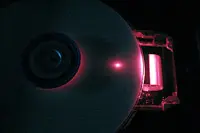Electronics News
Archive : 24 October 2014 год
 With the move towards keeping records on digital media, there is a need for a storage technology that has a long life time.
With the move towards keeping records on digital media, there is a need for a storage technology that has a long life time.
Hitachi, working with Professor Miura Kiyotaka of Kyoto University's School of Engineering, has developed technology that allows digital data to be read from and written to a device featuring 100 layers of fused silica glass. Whilst the recording density is said to be comparable to that of Blu-ray, fused silica glass could enable digital data to be stored for millions of years.
The 100 layer data recording approach was verified by the application of newly developed noise reduction technology to overcome interference from data recorded on other layers while trying to access data written in deeper layers within the fused silica glass.
Hitachi has been developing fused silica glass storage since 2009. After proposing the use of computed tomography to read data recorded with a femtosecond pulse laser, fused silica glass was confirmed as an effective storage medium. Using this technology, it is said to be possible to record data – or dots – on different layers by changing the laser's focal point. In 2012, a method was developed with Kyoto University to read the dots recorded in four layers using an optical microscope, whilst 26 layer recording was achieved in 2013, with a recording density equivalent to that of a DVD.
At 100 layers, the recording density is equivalent to that of a Blu-ray Disc, but issues arose in dot quality degradation and read errors resulting from crosstalk of data recorded in other layers.
Further work has shown that, with a gap of 60µm between layers, it is possible to read to and write from 50 layers on each side of a fused silica disc, giving a total of 100 layers, with the potential for even more layers.
Author
Graham Pitcher
Source: www.newelectronics.co.uk
